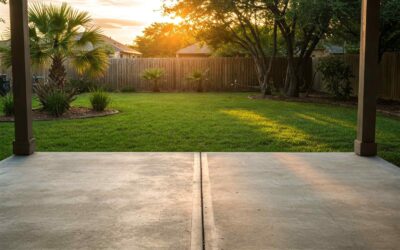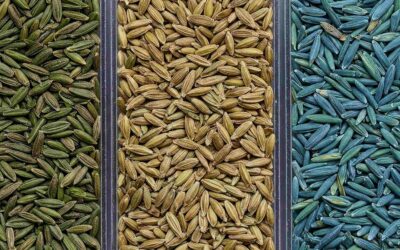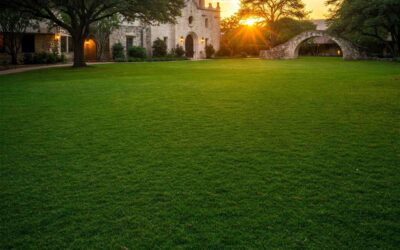Whether you enjoy a backyard picnic with the kids or your family includes a beloved dog or cat, it’s unlikely that your artificial grass will be entirely maintenance-free.
You need to clean artificial grass from time to time to ensure that it remains in peak condition. How do you do that?
Here we cover what you need to know about how to clean artificial grass — with extra sections on how to clean artificial grass dog urine and poop (which is always one of the first concerns of dog owners who install pet turf)
Why you need to clean artificial grass
You don’t need to fertilize, mow, aerate, lay weedkiller or even water synthetic grass regularly but that doesn’t mean it can just sit there for years on end and you can put your feet up forever!

Good artificial grass with a professional installation doesn’t come cheap — and costs considerably more than natural grass. But it’s an investment that will pay itself back after a few years of saved water and gardening costs if you look after it.
Properly-maintained artificial grass can last 10-15 years or more, so it’s an investment worth protecting.
You don’t need to do too much synthetic grass maintenance to achieve that but anyone who tells you that it’s maintenance-free is not being honest — and certainly doesn’t have dogs or kids.
What can affect the appearance and performance of your artificial grass?
Your backyard or front yard artificial grass area is exposed to the elements and affected by other factors that make it essential to clean it from time to time.
The main factors to bear in mind are:
- Climate: frequent rains can make cleaning essential, especially if your artificial grass area has been installed without much attention to drainage.
- Storms: stormy areas are susceptible to a buildup of debris like branches, twigs and dirt on artificial grass areas.
- Construction work: building work in the area creates dust that can easily accumulate on synthetic turf.
- Pets: dogs and other pets can urinate or poop on fake grass, which can lead to unsanitary messes and nasty odors.
- Kids: kids playing, consuming food and drink and generally being kids can leave a mess that needs cleaning up in kids’ play areas.
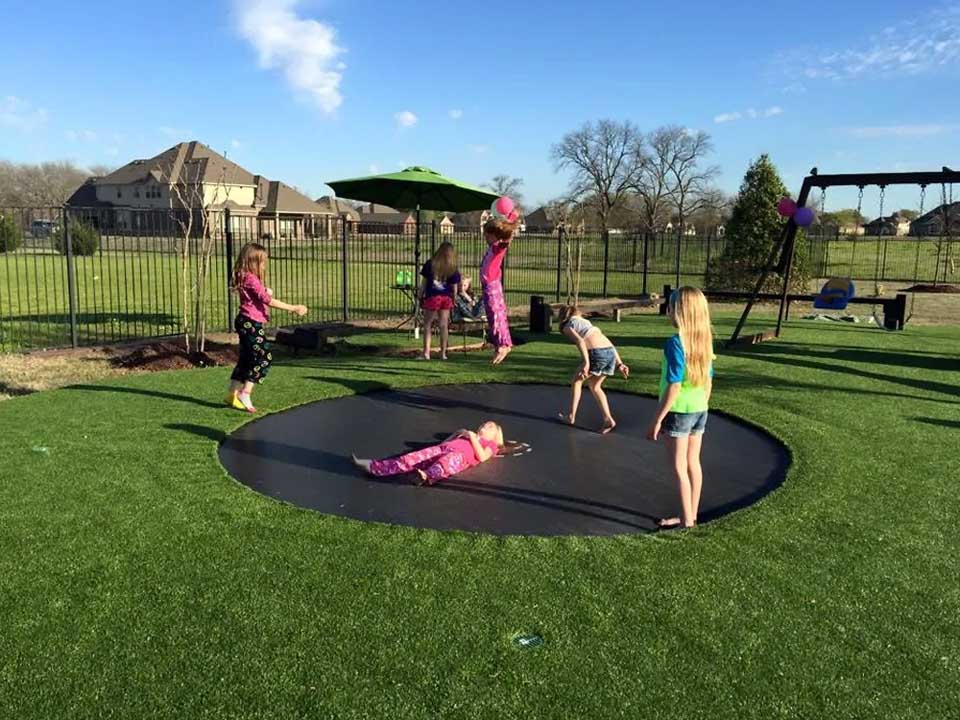
What’s the best way to clean artificial grass?
Some so-called “authorities” on the subject will suggest you deep clean your artificial grass once a month. Often, though, these authorities are cleaning product companies! You see where I’m going with this…
From our experience, some basic maintenance is needed from time to time but deeper cleaning is only needed every few months, depending on the types of factors outlined above.
If you live in a stormy area, with local building jobs ongoing and several large dogs using your artificial grass area daily, you’ll need to clean more often than a yard in a less extreme climate without construction or dogs — which you may only need to clean every few months.
All artificial grass should be kept free of debris like leaves, dust and dirt as much as possible. And every homeowner with artificial grass should have a leaf blower, turf rake or stiff-bristled brush kept handy as well as a suitable garden hose.
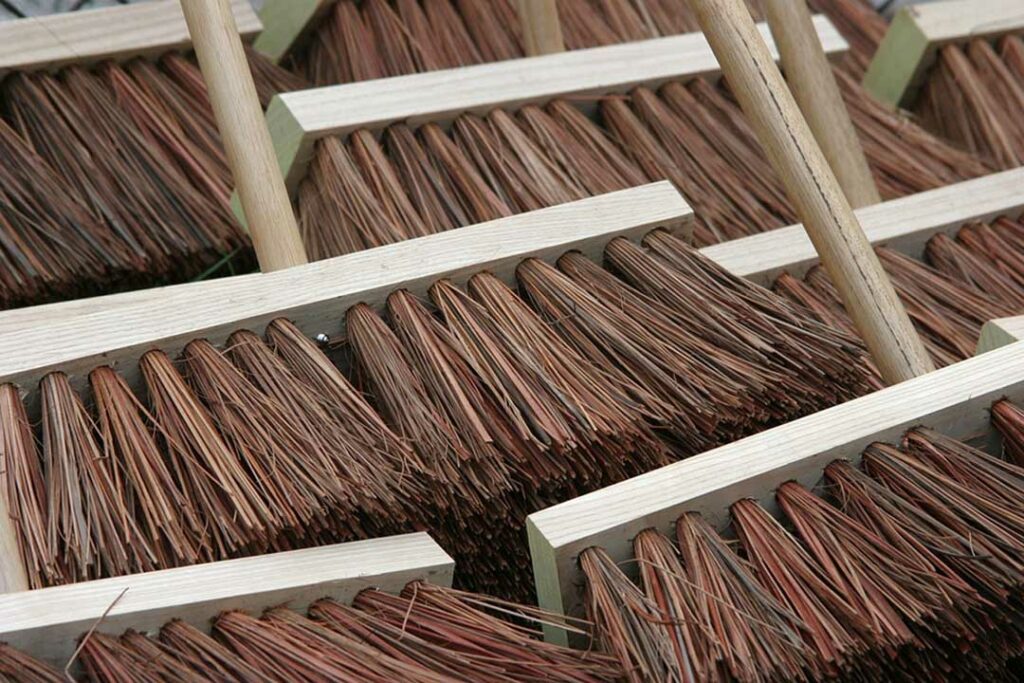
Weekly/monthly light clean
A weekly or monthly inspection and removal of debris is a great idea for an artificial backyard lawn. Use a leaf blower or a plastic/rubber-pronged rake to clear leaves and any other debris. This will prevent the buildup of bacteria that can attract flies, pests and other bugs on artificial grass.
It shouldn’t take long. Simply designate a corner of your yard to blow all the debris towards. Then collect and remove it.
When you use a rake on artificial grass, direct it against the natural direction of the fake grass blades, so that they are groomed into an upright position. This movement will also loosen any dirt that is stuck onto the grass blades. If you don’t have a plastic rake, use a stiff-bristled brush. Don’t use a metal rake.
If you find any stains, dust buildup or spillage from a drink, hose them down with a sufficiently powered garden hose. If you’re going to hose down the entire artificial grass area (not a bad idea unless the water restrictions are an issue for you), start from one end of the yard and move across the area using circular motions of the hose to clean.
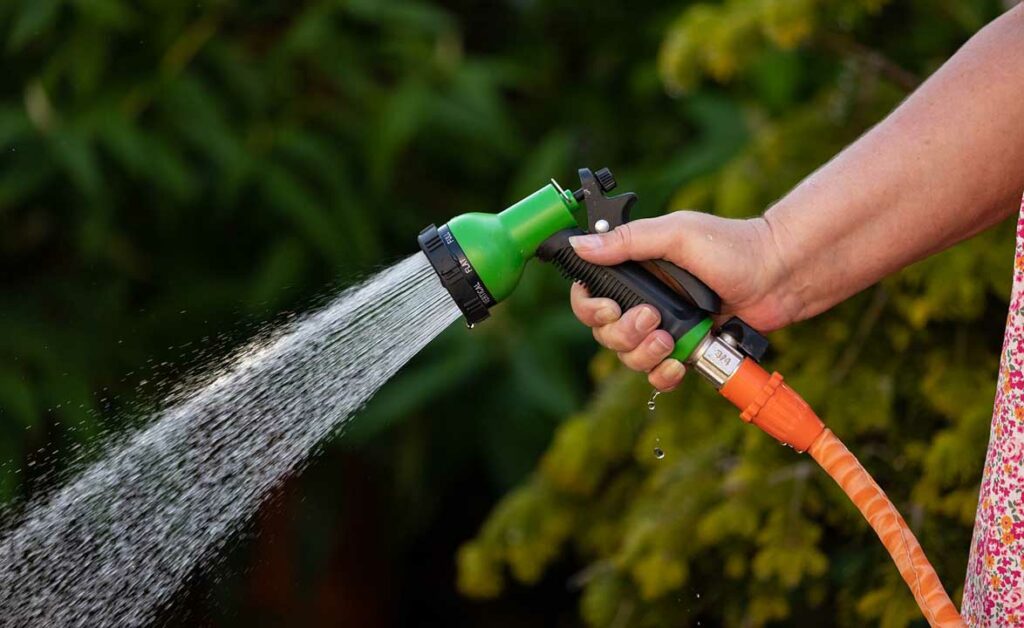
Deeper clean
For deeper cleaning of your artificial grass area, begin the same way by removing debris with a leaf blower or turf rake.
Alternatively, you can power wash your artificial grass. This will quickly remove any dirt and debris while also fluffing up the grass fibers so that they retain their natural greasy appearance. However, it’s essential to hold the hose at least a foot away from the grass to avoid damaging the blades.
Another good power-washing tip is to angle the power-washing nozzle against the natural direction of the grass blades to save you from having to rake the grass.
Any tough-to-remove stains or dirt that somehow withstands the power wash can be treated with an artificial grass cleaning solution. The science varies on this but you should find that applying bicarbonate of soda and spraying it with vinegar will clear most nasties (more about this below).
Best way to clean artificial grass for dogs
Many dog owners choose to install pet turf and it’s even used in many commercial play areas for pets. Check out our post on the pros and cons of artificial grass for dogs.
Part of the reason for its popularity is that dogs can pee or poop on artificial grass without it damaging it or leaving nasty odors behind.
But, again, your artificial grass area will benefit from some routine maintenance if you have dogs.
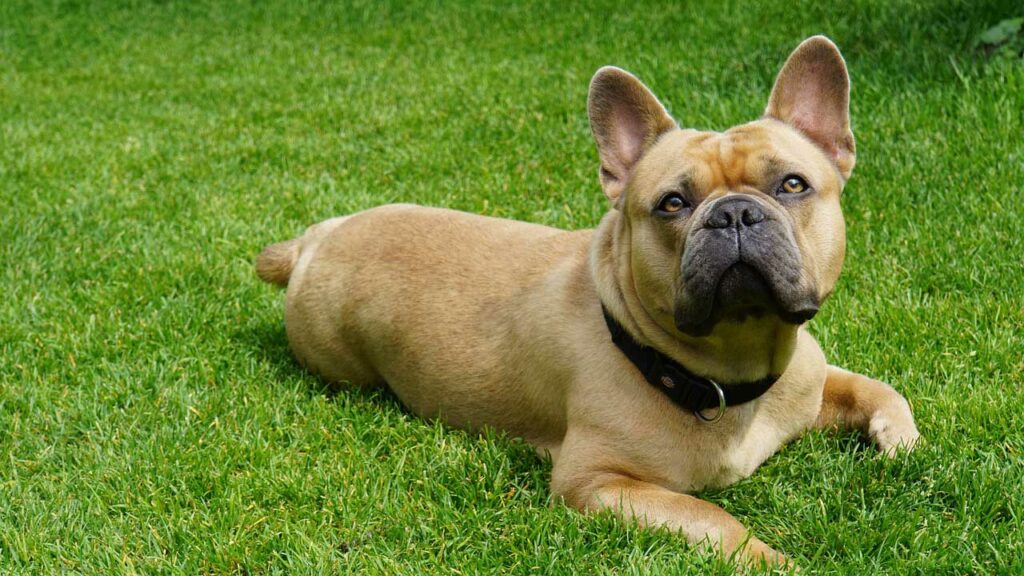
How to clean artificial grass dog urine
Even though artificial grass installed by our team for pets has excellent drainage and applies antimicrobial infills to prevent the buildup of bacteria and nasty odors, you may want to go a step further to remove all traces of dog urine.
You can spray a non-toxic, pet-friendly cleaning solution or mix water and vinegar yourself, which will kill bacteria and should eliminate any lingering smells.
If you only need to spray a specific spot, using a simple spray bottle should be fine. To treat a larger area, screw a hose-end sprayer onto the end of a garden hose. This looks like a plastic bottle with a spray bottle nozzle and is usually used to spray fertilizer. You can then easily hose down a large area.
Remember to rinse the area thoroughly and dry it before letting your dog back out into the grass.
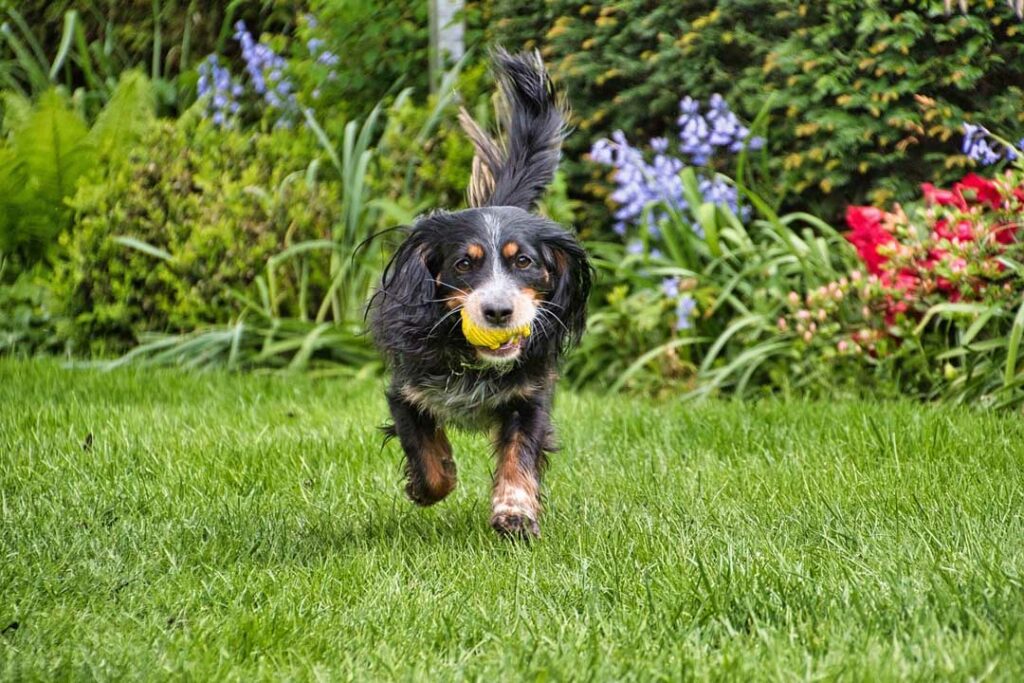
How to clean artificial grass dog poop
Dog poop on the grass is not a great look whether it’s real or fake grass. Clear up any solid waste with a scoop or bagger and dispose of it.
Then hose down the area to remove any remaining residue.
Should you use a commercial turf cleaner?
There are many commercial turf cleaners marketed for use on artificial grass. At Artificial Grass Pros, we don’t recommend a particular brand. The choice of whether to use a commercial cleaning solution or a homemade one is entirely up to the property owner.
You can make an effective homemade solution by mixing equal parts of water and vinegar. This can be sprayed directly on the artificial grass or used with bicarbonate of soda to remove most things that won’t come off with just water.

Some homeowners also use household detergent or bleach mixed with water (at least 10 parts water to one part bleach).
Most detergents are reasonably safe to use but bleach is a harsh chemical so we don’t recommend using it. If you insist on bleach, dilute it heavily and spot-test a tiny area first. Again, rinse the area thoroughly before your pets or children venture back there.
For a commercial turf cleaner, a natural, enzyme-based cleaning solution is safest for dogs but remember that just because it’s not toxic to humans doesn’t mean it’s not toxic to dogs (chocolate and onions are good examples of that).

Rinse thoroughly with water using a garden hose, whichever cleaning solution you use on your grass.
How can you clean sticky or stubborn residues from artificial grass?
Most substances should be fairly simple to remove from artificial turf. Any liquid spills should be quickly and gently blotted up with a paper towel.
But what about chewing cum caught in the grass or a coffee or red wine stain that just won’t come out? After all, everybody loves a picnic on their lawn with the family…

More stubborn stains may need a light detergent mix and a sponge or soft cloth to assist the process (again, rinse thoroughly after the spill is removed).
If sticky food is caught in your grass, you can usually scrape it off carefully with a knife. This should also work for most sticky residues like gum, tree sap, lipstick or paint.
Mineral spirits may make the job a little easier — just soak a soft cloth in a small amount of spirits and carefully dab the residue off the blades of grass (wear gloves to protect your hands and a respirator, if possible, to avoid the fumes).
Occasionally, extra-stubborn chewing gum may need to be frozen using dry ice or aerosol refrigerants. The Artificial Grass Pros team can help if you’re in this situation — give us a call at 512.296.1500 if you’re in the Austin area.
Cleaning methods to avoid with artificial grass
To prevent damage, certain practices should be avoided when cleaning synthetic grass. The most common ones we see are:
- Metal rakes — use a plastic or rubber-pronged rake or stiff-bristled broom to remove leaves and debris as this is gentler on your grass surface.
- Using undiluted bleach — this can cause damage and discoloration.
- Doing nothing — not technically a “cleaning method” but it’s harmful for your artificial grass to neglect maintenance altogether.

How-Not-to-Clean-Artificial-Grass-Metal-Rake
FAQs
How long does artificial grass last?
High-quality artificial grass that is well maintained can last 10-15 years or more. But lower-quality grass with high foot traffic will struggle to last the distance and may be adversely affected by extremes of climate (torrential rain and excessive sunlight).
The key is in working with an established, reliable supplier that professionally installs high-quality grass — like Artificial Grass Pros.
Can you vacuum artificial grass?
You can vacuum clean artificial grass if necessary to eliminate dust, dirt and other accumulated debris but before you do that, read these tips on vacuuming synthetic turf.
Will cleaning artificial grass damage the infill?
If your artificial grass is installed by Artificial Grass Pros, it will include an antimicrobial infill that helps to keep odors from pet waste at bay and helps the grass to maintain a more natural appearance.
If you clean your artificial grass as directed using the suggested tools, the turf infill will not be adversely affected.
Install and maintain the best artificial turf…
Artificial grass can withstand most of what humans and pets can throw at it but it does need a helping hand from time to time to keep it clean and looking its best.
If you regularly clear debris, hose it down occasionally and clear any stubborn stains or odors using natural cleaning products, your artificial grass area will last longer and everyone will be happier.
The first step in maintaining a synthetic turf area that looks the part is to install it properly. At Artificial Grass Pros, we can look after that from start to finish. Discuss your ideas by reaching out to our helpful team. We’ll be happy to provide a quote if you call 512.296.1500.



